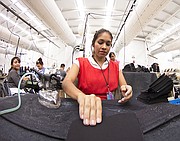TECHNOLOGY
Levi Strauss Commits to Greener Supply-Chain Process With 2025 Target
Not only has Levi Strauss & Co. made a commitment to invest in energy-saving operations at its own properties, but it has also announced that it is approaching its supply-chain partners to commit to more sustainable practices.
The San Francisco–based jeans and apparel leader—which manufactures the Levi’s, Dockers, Signature by Levi Strauss & Co. and Denizen brands—announced it is on track to reach its 2020 climate targets for owned-and-operated facilities, a goal that was set in 2012.
Rather than basking in this accomplishment, the company launched a larger initiative, committing to reduce by 2025 its greenhouse-gas emissions by 90 percent in its owned-and-operated facilities and 40 percent in its supply chain.
During a 2016 audit, the company discovered that most of its greenhouse-gas emissions occurred outside of its owned-and-operated facilities—with 63 percent traced back to the supply chain and 36 percent from consumer use and disposal.
“The bulk of our carbon emissions that we’re responsible for as a company comes from the supply chain,” said Michael Kobori, Levi Strauss & Co.’s vice president of social and environmental sustainability. “Our target there is 40 percent, and we’re really focused on our direct-contract suppliers at the manufacturing level as well as the fabric mills.”
Bringing greater sustainability to its mills allows Levi Strauss & Co. to help its partners clean up one of the notoriously dirty areas of apparel manufacturing. The company also has the support of one of the world’s most powerful organizations to help make the shift toward cleaner manufacturing.
“The reason that we’re focused there [fabric mills] is because that is where we have the most direct relationship and we can utilize this Partnership for Cleaner Textile (PaCT) program that we piloted last year with the International Finance Corporation, which is the private-sector arm of The World Bank,” Kobori said.
Through the PaCT program, Levi Strauss & Co. has already worked with six of its key manufacturing partners to develop more-sustainable practices. After the IFC’s experts surveyed the supply chain, they outlined improvements that could reduce energy consumption by 20 percent and save the six partners more than $1 million.
“This kind of leadership sends a strong signal reaffirming the recognition that combating climate change is a shared responsibility between the public and private sectors and an excellent business opportunity,” Alzbeta Klein, IFC director for climate business, said in a statement.
In September 2017—following the United States’ June 2017 withdrawal from the Paris Climate Agreement—Levi Strauss & Co. joined Science Based Targets, an organization that helps companies reduce greenhouse-gas emissions based on climate science.
“Our new target has been approved by Science Based Targets’ initiative, which is made up of four of the leading NGOs [non-governmental organizations] in the climate space,” Kobori said.
Levi Strauss & Co. is making changes to its owned-and-operated facilities, which are considered scope 1, or direct emissions, and scope 2, which are indirect emissions from the generation of purchased energy, according to the Greenhouse Gas Protocol. The 40 percent reduction in the supply chain would affect emissions that are considered scope 3, the indirect emissions over which a company has no control.
Convincing suppliers to collaborate on sustainable practices might seem to be a daunting task, but Kobori is optimistic about the adoption of these practices by the company’s partners. Citing a global vendor meeting that convened earlier in 2018, he found that many of the company’s partners were already considering more-sustainable practices.
“We talked to them about our key priorities including climate change,” he said. “I was pleasantly surprised that the majority of our suppliers are not only thinking about and pursuing energy-efficiency programs, but a number of them are thinking about renewable energy.”
While Kobori might seem a bit modest about the difficult work that goes into aligning an apparel supply chain with a greener initiative, his company’s sustainability partners are quick to praise the apparel manufacturer’s work, recognizing the challenges that can be involved in this type of undertaking.
“A lot of companies might say, ‘For our own plants and our own manufacturing facilities, we’re going to reduce our carbon footprint by 25 percent,’ but setting those goals for supply chains is a very different ball of wax,” said Mindy Lubber, chief executive and president of Ceres, a sustainability nonprofit organization based in Boston. “It is much more audacious, ambitious and difficult to make happen.”
In 2009, Levi Strauss & Co. partnered with Ceres to form BICEP—Business for Innovative Climate and Energy Policy.
Over the years, it’s become clear that the challenge is to convince suppliers that a shift toward climate-friendly practices is beneficial on many levels. “Acting on issues—whether it’s climate change or equitable practices in your workplace and that of your supply chain—is not only about good values, it is about mitigating risk and increasing opportunity,” she said. “It is positive value for the corporate bottom line.”
As consumers remain informed regarding companies that use sustainable manufacturing practices—and consider this information when making purchasing decisions—Lubber revealed that job seekers and investors are also taking notice.
“This overall work that Levi Strauss is doing on sustainability makes extraordinary sense,” she explained. “It puts them in a leadership position with customers, investors, future employees and present employees.”






















